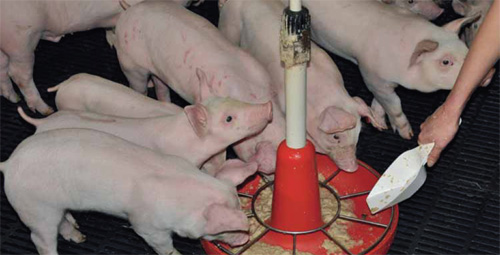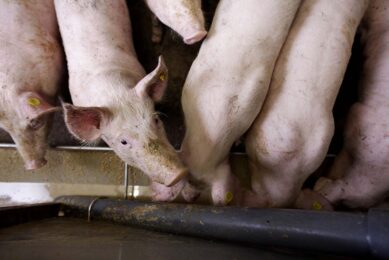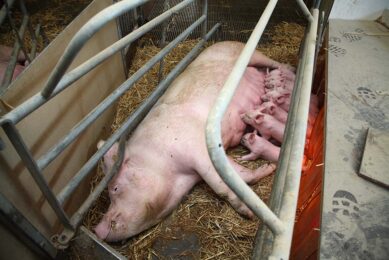New strategies in piglet nutrition: Gel feeding

In recent years it has been recognised that early feed intake after weaning is essential for the performance of pigs during the whole fattening period. Accounting for the scientific progress, beside milk replacers or dry prestarter and starter diets, another type of piglet feed is now entering the market: Gel.
In modern pig production facilities piglets are born in a more or less sterile environment. After birth, sow milk provides the piglets with all required nutrients and water. Due to the steady increase of litter sizes and modern breeds’ high growth potential, sow milk becomes scarce relatively early in a piglet’s life. When milk yield is lower than the piglet’s demand, piglets are supplemented with prestarter diets. However, piglets are not familiar with their structure, flavour and taste, thus intake of dry feed is very low. Moreover, due to poor environmental stimulation piglets play less and therefore it takes some time (hours or a few days) to learn how to use the technical equipment such as feeders or drinkers.
Weaning associated problems
In commercial production systems, piglets are weaned at three to four weeks of age. Suddenly, piglets are separated from their mothers and littermates. Studies have shown that only 50% of piglets drink water during the first 24 hours post-weaning. Thus, there is high risk of dehydration. One possible reason for non-drinking is, that piglets have not learned to use the drinkers since the pre-weaned diet (milk) provides both nutrients and water. Furthermore, dehydrated pigs do not eat, and with not eating even worse things start happening. Intestinal villus height is related to feed intake, and withdrawal of luminal nutrients leads to intestinal atrophy. This is followed by a reduced absorptive surface and increased intestinal cell turnover. Thus more energy goes to replenish intestinal cells instead of pig growth. Moreover, reduced barrier function and mucin secretion of the intestinal cells in combination with undigested nutrients, which were excessively fermented by bacteria, result in increased risk of diarrhoea and mortality.
Gel feeding during the suckling period
To prevent these detrimental effects, adequate hydration of the piglets as well as fast and high feed intake after weaning is of high importance. Nowadays, products with high palatability and a yoghurt- or pudding- like, gelatinous consistency are entering the market. All these products differ in their nutritional strategy. Most of the products are recommended for use in big litters during suckling. Being rich in high quality nutrients (e.g. blood plasma) and probiotic compounds, the arrival of these products may be recognised as the new era of milk replacers in piglet nutrition. Other products are recommended as treatment during acute gastro-intestinal disturbances in suckling piglets.
Gel feeding to ease transition
Another gel feeding strategy is to focus on fast hydration of piglets during the first few days after weaning and to provide enough nutrients to prevent intestinal atrophy. Thereby, piglets will not be completely saturated by the gel and thus, will further search for feed. The physical form of the diet during the immediate postweaning period has a large impact on voluntary feed intake. The soft consistency of gel has the advantage that piglets smack during consumption of gel. For piglets this sound is associated with suckling, thus it attracts other piglets and synchronises eating.
After the piglets have learned to eat this way and become familiar with the technical equipment, the transition to dry feed is easy. For piglet management an early dry feed intake is preferred to prolonged liquid or gel intake, as dry feed normally has a higher nutrient and energy density. Thus, this kind of gel based nutritional supplement clearly aims for transition to dry feed and thereby differentiates from the above mentioned milk-replacer strategy. From a nutritional point of view, the more often gel is fed in small portions the better. Although, these gel supplements are provided as ready to feed products and thus being less time consuming than dry products which have to be mixed with water before feeding, feeding frequencies more than twice daily will hardly be managed. Accounting for this, best effects were obtained when gel is fed twice daily the first five to seven days after weaning.
The feeding recommendations are as follows: From the first day on provide a normal starter diet, additionally during the first day post-weaning pure gel is fed in separate feeders, the following days gel and dry starter diet were mixed in those feeders. Starting with a mixture of 2:1 (gel:dry feed), the proportion of gel is stepwise decreased. In systems where the small and light weight piglets can be separated, gel feeding could be of special interest as small and light weight piglets show greatest response to gel supplementation. As a result, small and light weight piglets will catch up and the incidence of infections and mortality will be decreased.
Join 18,000+ subscribers
Subscribe to our newsletter to stay updated about all the need-to-know content in the pigsector, three times a week. Beheer
Beheer










 WP Admin
WP Admin  Bewerk bericht
Bewerk bericht